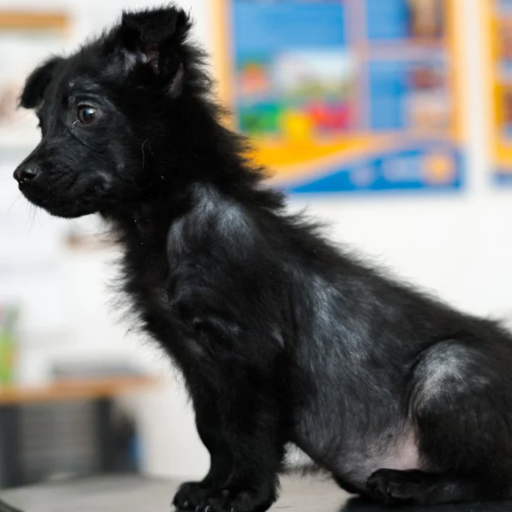Determining Factors in Canine Hair Regrowth After a Scab
The crucial query, “How long for a dog’s hair to grow back after a scab?” is answered by the origin of the scab. A superficial wound, such as a minor scrape or nick, will typically see hair regrowth without complications. If, however, the scab arises from more severe circumstances like a skin condition (e.g., mange or allergies), hair regrowth in the region might be a complex task. In situations like these, proper care and treatment become vital for stimulating healthy regrowth in the affected areas. Consultation with a veterinarian is highly advised to devise an appropriate treatment strategy.
Note: This article primarily addresses minor patches of hair loss due to a scab. For substantial hair loss in your dog, prompt consultation with a vet is paramount.
cutepetcare

Estimating Healing and Hair Regrowth Time Based on Severity of Dog Injuries
Injuries in dogs vary in type and severity, each having its own healing timeline and implications for hair regrowth. Here’s a simplified guide to help you understand the approximate healing period and hair regrowth timeline for different levels of injuries:
- Minor Surface Wounds (e.g., superficial cuts, scrapes, abrasions): These shallow injuries generally heal within 1-2 weeks. Minimal tissue damage means hair follicles are typically unaffected, allowing for normal hair regrowth, which may take a few weeks to a couple of months.
- Moderate Wounds (e.g., deeper cuts, minor burns): Such injuries may take 2-4 weeks to fully heal due to deeper tissue damage. Hair regrowth can be expected within 1-3 months, depending on how much the hair follicles were impacted by the injury.
- Severe Wounds (e.g., deep lacerations, severe burns): Healing may take several weeks to months, given the significant damage to skin layers and potentially hair follicles. Hair regrowth might take several months and, in some cases, could be patchy or incomplete if the injury caused extensive follicular damage.
- Chronic Skin Conditions (e.g., allergies, mange, fungal infections): Healing timelines can be very variable, depending on the condition and its treatment. Hair regrowth could take months and might require additional specific treatments.
In-Depth Understanding of Hair Regrowth Challenges
Some scenarios might result in hair not fully regrowing where a scab was previously, perhaps due to scarring or other factors. As a responsible pet parent, you can support your furry friend by facilitating healthy hair regrowth. Consider using canine-specific gentle shampoos or conditioners. Delve deeper into alternative treatments like topical creams or supplements, which scientific research backs for stimulating hair growth1. Today’s online platforms make consulting a vet easier than ever, especially when choosing the right products.
Monitoring Your Dog’s Scabs: Ensuring Proper Healing and Hair Regrowth
Scabs are part and parcel of your dog’s healing process, forming a protective layer over wounds to guard against infection. Yet, it’s not just their formation but their behavior and eventual disappearance that’s essential to monitor. If the scabs on your dog worsen, spread, or change significantly in appearance, it’s a clear indication to seek immediate veterinary attention. Such shifts could hint at complications in the healing process, such as an infection or deeper skin condition needing further treatment. While scabs typically heal around two weeks, the timeline can vary depending on factors like the wound’s size, depth, and location.
Be particularly observant for signs of discomfort or abnormal behavior in your dog around the healing scab, such as frequent licking, scratching, or biting. These actions can hinder healing and elevate infection risk. If your dog appears overly focused on the scab, protective measures like an Elizabethan collar can deter further interference. Additionally, the emergence of pus, heightened redness, or a foul odor from the scab may signal an infection that should be urgently addressed. Systemic infection indicators like loss of appetite, lethargy, or fever also warrant immediate attention. Ensuring proper nutrition during the healing phase is paramount as a balanced diet fosters overall health, including skin regeneration and hair regrowth. If your dog is not eating adequately, this can slow the healing process and hair regrowth following a scab.
Supporting Fur Growth After an Injury
If your dog’s fur remains defiantly absent after a cut, you have a variety of options to encourage healthy regrowth. Regularly brushing your dog’s fur with a soft brush or comb in the affected area can promote blood circulation in the skin, leading to hair growth. Omega-3 fatty acid supplements can also aid in maintaining skin and coat health2.
Topical ointments or creams designed explicitly for fur regrowth offer another avenue. These products often contain high levels of vitamins A and E, biotin, and even caffeine, surprisingly enough. Caffeine can nourish the follicles and stimulate new hair growth3. Consulting with a local veterinarian can provide up-to-date recommendations for creams or ointments. Lastly, a high-quality pet-safe moisturizer can supplement these treatments.
Typically, with the right treatment mix, your dog’s fur should start to regrow within a few weeks. Persistent hair growth issues warrant a consultation with a veterinarian to identify any underlying cause preventing regrowth.
Unraveling the Reasons Behind Impaired Hair Regrowth
Several factors might contribute to your dog’s hair not growing back adequately. These range from underlying skin conditions, such as mange or allergies, to inadequate nutrition, poor grooming habits, or excessive sunlight exposure. An area may also be permanently scarred due to an injury or trauma. Professional diagnosis from a vet is key to developing an effective treatment plan.
Understanding the Causes of Bald Spots in Dogs
Bald spots in dogs can develop due to a multitude of reasons and are often the result of either skin abnormalities or tissue damage. It’s essential to understand that when a scab forms over a wound, it can sometimes interfere with hair regrowth, leading to a bald spot.
- Skin Conditions: Commonly, bald spots occur as a result of various skin conditions. These include allergies, mites (such as mange), bacterial infections, fungal infections like ringworm, or even skin tumors. These conditions often lead to excessive itching, causing dogs to scratch or chew at their skin, damaging hair follicles and leading to hair loss.
- Trauma and Tissue Scarring: If your dog has had a significant injury that led to a deep wound or scar, this could be the cause of the bald spot. In such cases, the trauma might have damaged the hair follicles in that area, making hair regrowth difficult or even impossible.
- Hormonal Imbalances: Certain hormonal imbalances, such as hypothyroidism or Cushing’s disease, can also lead to hair loss and subsequent bald spots in dogs.
- Nutritional Deficiencies: A diet lacking in essential nutrients required for maintaining healthy skin and hair, such as omega-3 fatty acids, can contribute to hair loss.
When dealing with a bald spot on your dog, it’s important not to make assumptions. Consult with a veterinarian to determine the exact cause. The vet may run various diagnostic tests, including skin scrapings, blood tests, or even a biopsy to get to the root of the issue. Understanding the cause is critical, as it allows for targeted treatment to not only help with hair regrowth but also address the underlying condition affecting your dog’s health.
Approaches to Treating Bald Spots in Dogs
Proper care and attention can result in the healing of most minor scabs and bald spots, with no lasting effects. Techniques include regular brushing and providing omega-3 supplements.
Understanding the Dog’s Hair Growth Cycle
Just like humans, dogs also go through hair growth cycles. Understanding this process can provide insights into why it might take longer for some dogs’ hair to grow back after a wound compared to others. The cycle has four stages: anagen (active hair growth), telogen (resting phase), catagen (transition phase), and exogen (shedding phase). The length of each phase depends on factors such as the dog’s breed, age, health status, and even the time of year. By understanding this cycle, you can set more realistic expectations for hair regrowth after a scab and identify any anomalies quicker.
Factors That Can Affect Hair Regrowth
Certain factors can impact your dog’s hair regrowth speed. Age is a significant one – older dogs may take longer to regrow hair after a wound compared to younger ones. The dog’s overall health status is another factor; dogs with chronic health conditions or those under stress might experience slower hair regrowth. Moreover, genetic factors can play a part too. Some breeds naturally have slower hair growth rates or thinner hair density. Recognizing these factors can help you manage expectations about hair regrowth and alert you to potential underlying issues if the hair takes much longer to regrow.
Importance of Wound Care in Hair Regrowth
Proper wound care is crucial not only for your dog’s overall health but also for promoting hair regrowth. Cleaning the wound, ensuring it’s free of infection, and protecting it from further damage are all necessary for the healing process, and consequently, for the hair to regrow. Depending on the severity of the wound, this might involve topical treatments, bandaging, or even vet-prescribed medications. Ensuring the wound heals correctly is the first step to successful hair regrowth.
Alternative Treatments for Hair Regrowth
In cases where traditional methods aren’t working, there are alternative treatments available to help promote hair growth. Laser therapy, for instance, is becoming increasingly popular in veterinary medicine for its wide range of uses, including stimulating hair growth. Another option might be platelet-rich plasma (PRP) therapy, which uses the dog’s own blood components to encourage cell growth and repair. While these options may not be necessary for most cases of hair loss following a scab, they could be worth considering for more stubborn or severe situations, under vet guidance.
By being aware of these considerations, you can support your dog more effectively through the healing process and ensure they’re on the best path to regain their luscious coat.
Preventative Measures to Reduce the Risk of Scabs and Bald Spots
While treating existing scabs and promoting hair regrowth is crucial, prevention is equally significant. Ensuring your dog has a balanced diet rich in essential nutrients can contribute significantly to overall skin and coat health. Regular grooming helps to keep the skin clean, reducing the risk of infections that may lead to scabs. Make use of dog-friendly sunscreens if your furry friend spends a lot of time outdoors, as excessive sun exposure can damage their skin and coat. Providing plenty of fresh water and shade can also help to keep your dog healthy and comfortable, reducing the risk of skin damage and subsequent hair loss.
Regular Check-Ups With Your Veterinarian
The key to any health issue, including hair loss, is early detection. Regular check-ups with your veterinarian can help identify potential problems before they become severe. Your vet can also recommend specific products or dietary changes that can boost your dog’s skin health, contributing to the prevention of scabs and promoting hair regrowth.
Frequently Asked Questions
Q: How can I help my dog’s hair grow back after a scab? A: There are several ways to help stimulate hair growth. This includes using gentle shampoos or conditioners made for dogs, discussing with your veterinarian about alternative treatments such as topical ointments or supplements that promote hair growth, and maintaining a balanced diet for your dog.
Q: Can all types of dog hair grow back after a scab? A: It depends on the cause of the scab and the overall health of your dog. Superficial wounds will likely see hair regrowth, but more severe conditions such as skin diseases or allergies may complicate the process.
Q: How long does it usually take for a dog’s hair to grow back? A: Typically, with proper care, your dog’s fur should start to regrow within a few weeks after the healing of the wound. If you notice no improvement, consult with a veterinarian.
Q: What are the causes of bald spots in dogs? A: Bald spots can develop due to several reasons, including skin conditions, trauma, severe scarring of tissue, inadequate nutrition, poor grooming habits, or even excessive sunlight exposure.
Q: What should I do if my dog’s hair isn’t growing back? A: If your dog’s hair isn’t growing back, it’s important to consult with a veterinarian. There could be an underlying health issue preventing hair regrowth, and a professional diagnosis is key to developing an effective treatment plan.
With these steps, you can ensure your dog’s hair regrowth after a scab is healthy, leading to a happier, more comfortable pet.

Doctor of Veterinary Medicine (D.V.M.) at Nation Taiwan University,Master of Science (M.S.) in Biomedical Engineering at National Taiwan University of Science and Technology





